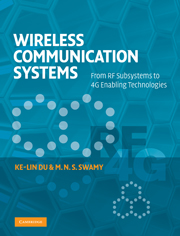Book contents
- Frontmatter
- Contents
- Preface
- Abbreviations
- 1 Introduction
- 2 An overview of wireless communications
- 3 Channel and propagation
- 4 Cellular and multiple-user systems
- 5 Diversity
- 6 Channel estimation and equalization
- 7 Modulation and detection
- 8 Spread spectrum communications
- 9 Orthogonal frequency division multiplexing
- 10 Antennas
- 11 RF and microwave subsystems
- 12 A/D and D/A conversions
- 13 Signals and signal processing
- 14 Fundamentals of information theory
- 15 Channel coding
- 16 Source coding I: speech and audio coding
- 17 Source coding II: image and video coding
- 18 Multiple antennas: smart antenna systems
- 19 Multiple antennas: MIMO systems
- 20 Ultra wideband communications
- 21 Cognitive radios
- 22 Wireless ad hoc and sensor networks
- Appendix A The Q-function
- Appendix B Wirtinger calculus
- Index
12 - A/D and D/A conversions
Published online by Cambridge University Press: 05 June 2012
- Frontmatter
- Contents
- Preface
- Abbreviations
- 1 Introduction
- 2 An overview of wireless communications
- 3 Channel and propagation
- 4 Cellular and multiple-user systems
- 5 Diversity
- 6 Channel estimation and equalization
- 7 Modulation and detection
- 8 Spread spectrum communications
- 9 Orthogonal frequency division multiplexing
- 10 Antennas
- 11 RF and microwave subsystems
- 12 A/D and D/A conversions
- 13 Signals and signal processing
- 14 Fundamentals of information theory
- 15 Channel coding
- 16 Source coding I: speech and audio coding
- 17 Source coding II: image and video coding
- 18 Multiple antennas: smart antenna systems
- 19 Multiple antennas: MIMO systems
- 20 Ultra wideband communications
- 21 Cognitive radios
- 22 Wireless ad hoc and sensor networks
- Appendix A The Q-function
- Appendix B Wirtinger calculus
- Index
Summary
Introduction
Analog input signals are converted into digital signals for digital processing and transmission. The analog-to-digital (A/D) converter (ADC) performs this functionality using two steps: the sample-and-hold (S/H) operation, followed by digital quantization. The ADC is primarily characterized by the sampling rate and resolution. A sampling rate of above twice the Nyquist frequency is a must; otherwise, aliasing occurs and the result is not usable. A higher sample rate leads to a more accurate result, but a more complex system. The successive-approximation ADC successively increases the digital code by digitizing the difference until a match is found. The successive-approximation ADC is the most popular type of ADC. The sigma-delta (Σ-Δ) ADC uses oversampling and noise shaping to significantly attenuate the power of quantization noise in the band of interest.
The digital-to-analog (D/A) converter (DAC) is used to convert the processed digital signal back to an analog signal by comparing it to the input voltage. This chapter introduces ADCs and DACs that are used in wireless communication systems.
Sampling
Ideal and natural sampling
An analog signal x(t), bandlimited to fmax, can be transformed into digital form by periodically sampling the signal at time nT, where T is the sampling period.
Information
- Type
- Chapter
- Information
- Wireless Communication SystemsFrom RF Subsystems to 4G Enabling Technologies, pp. 464 - 488Publisher: Cambridge University PressPrint publication year: 2010
